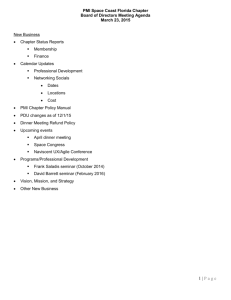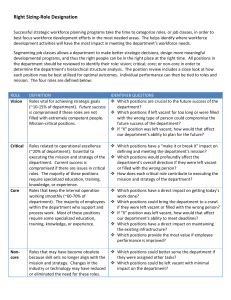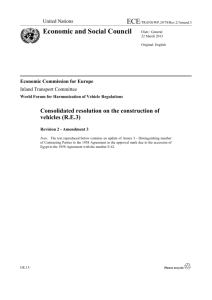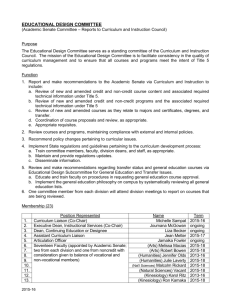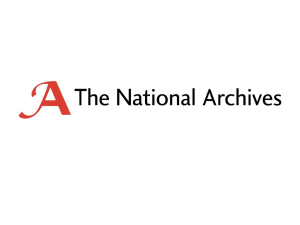Final Committee Revision 4-26-12 PROPOSED CHAPTER 1384
advertisement
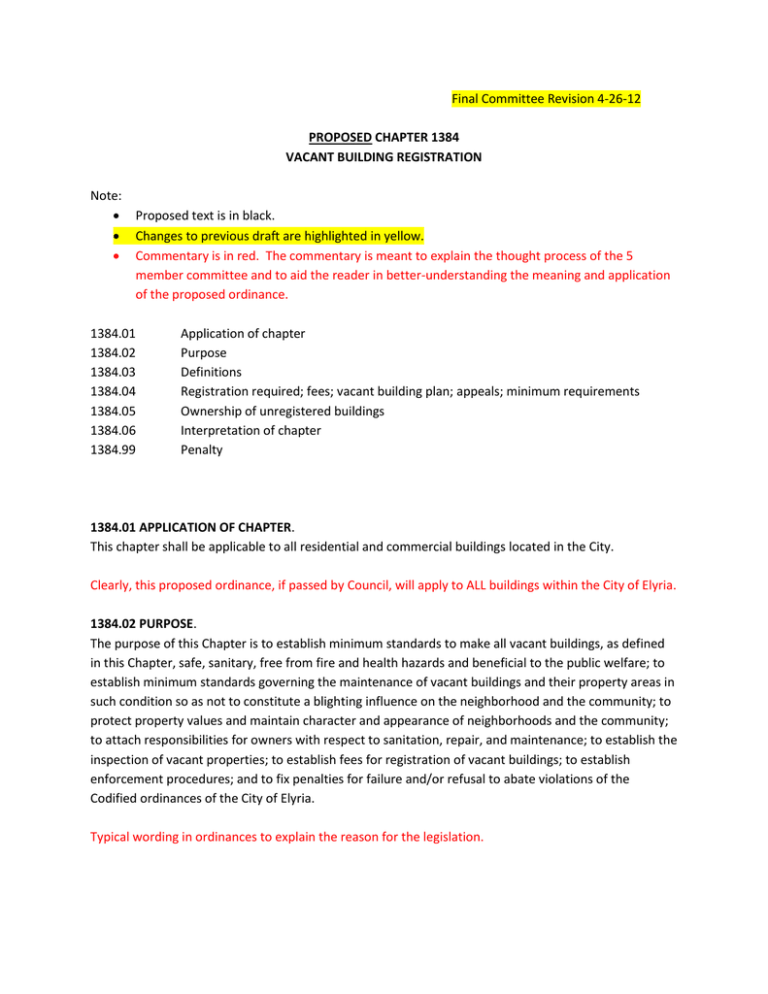
Final Committee Revision 4-26-12 PROPOSED CHAPTER 1384 VACANT BUILDING REGISTRATION Note: Proposed text is in black. Changes to previous draft are highlighted in yellow. Commentary is in red. The commentary is meant to explain the thought process of the 5 member committee and to aid the reader in better-understanding the meaning and application of the proposed ordinance. 1384.01 1384.02 1384.03 1384.04 1384.05 1384.06 1384.99 Application of chapter Purpose Definitions Registration required; fees; vacant building plan; appeals; minimum requirements Ownership of unregistered buildings Interpretation of chapter Penalty 1384.01 APPLICATION OF CHAPTER. This chapter shall be applicable to all residential and commercial buildings located in the City. Clearly, this proposed ordinance, if passed by Council, will apply to ALL buildings within the City of Elyria. 1384.02 PURPOSE. The purpose of this Chapter is to establish minimum standards to make all vacant buildings, as defined in this Chapter, safe, sanitary, free from fire and health hazards and beneficial to the public welfare; to establish minimum standards governing the maintenance of vacant buildings and their property areas in such condition so as not to constitute a blighting influence on the neighborhood and the community; to protect property values and maintain character and appearance of neighborhoods and the community; to attach responsibilities for owners with respect to sanitation, repair, and maintenance; to establish the inspection of vacant properties; to establish fees for registration of vacant buildings; to establish enforcement procedures; and to fix penalties for failure and/or refusal to abate violations of the Codified ordinances of the City of Elyria. Typical wording in ordinances to explain the reason for the legislation. 1384.03 DEFINITIONS. The following definitions shall apply to this chapter: A. “Owner” means any person who, alone or jointly or severally with others, shall have the legal or equitable title to a property, and shall include executors, administrators, trustees, or guardians of the estate of the owner, and purchaser or assignee under a certificate of sale pursuant to a mortgage foreclosure. The term “owner” shall also include partnerships and other unincorporated associations. Any individual owner, regardless of whether he or she shares ownership responsibility with any other person, any general partner of a partnership, and any officer of a corporation or unincorporated association, shall have direct and personal responsibility and liability for compliance with the provisions of this chapter. B. “Vacant Building” means any structure or part of a structure which is unoccupied and which constitutes an unsafe building or public nuisance. “Unsafe building” and “public nuisance” as used in this Code, shall mean and include the following: 1. Any building, house, shed, fence, or other man-made structure, or part thereof, which, by reason of its condition, endangers human health, life or limb or is likely to cause the spread of disease or otherwise cause injury to the health of persons or to surrounding neighborhood structures; 2. Any building, house, shed, fence, or other man-made structure, or part thereof, which, by reason of faulty construction, age, lack of proper repair or other cause, is especially liable to the occurrence of fire or creates a fire hazard; 3. Any building, house, shed, fence, or other man-made structure or part thereof, which, by reason of faulty construction, age, lack of proper repair or other cause, is especially liable to cause injury or damage to persons or property by collapse of any part of the structure; 4. Any building, house, shed, fence, or other man-made structure, or part thereof, which, because of its condition or lack of doors or windows, is unsecured, open and available to and frequented by malefactors or disorderly persons or juveniles who are not lawful occupants of such structure; and 5. Any building, house, shed, fence, or other man-made structure, or the area surrounding any of the foregoing structures, which, because of the lack of reasonable and adequate maintenance causes a deteriorating and blighting influence on nearby properties and causes depreciation in the use, enjoyment and value of properties in the immediate surrounding areas to such an extent that it is harmful to the community in which such structure is situated. Definitions are extremely important to fully understand any code. When definitions are added to an ordinance, the terms being defined do not have the same meaning as what one would find in Webster’s Dictionary. The reader of this proposed ordinance should carefully read the definitions and apply THAT definition to the proposed text. For example, a “vacant building” using Webster’s Dictionary is any building that is not occupied. In this ordinance, a “Vacant Building” is both vacant and either “unsafe” or is a “public nuisance”. The five different types of “unsafe buildings” and “public nuisance” buildings are identified in subsections 1384.03, B, 1-5. The committee feels the intent of this proposed ordinance is to require owners of buildings that are vacant and have not been maintained over a period of time to register the property, pay a fee, have it inspected, and clean it up, inside and out…and then to maintain it in a safe and sanitary condition until it is reoccupied. The intent is NOT to penalize owners of every vacant building. A property on which there is a “vacant building”, using the definition in this ordinance can be classified as “unsafe” or can be a “public nuisance” if there are high weeds, abandoned vehicles, broken windows, dilapidated porches, unsecured openings, and a myriad of other problems. 1384.04 REGISTRATION REQUIRED; FEES; VACANT BUILDING PLAN; APPEALS; MINIMUM REQUIREMENTS. A. Any building presently located within the City which is determined to be a vacant building, as defined in this Chapter, or which hereafter becomes a vacant building, shall be registered by the owner thereof with the Chief Building Official within ninety (90) days from its last occupancy. Understand the definition of “vacant building”. We added “as defined in this Chapter” to remind the reader to refer to the definition of “vacant building” as used in this Chapter. B. Registration shall be made on forms supplied by the Chief Building Official and shall include: 1. The name, address and telephone number of the owner; 2. The name, address and telephone number of a local agent or representative; 3. The names, addresses, and telephone numbers of all persons with any legal interest in the property, building and premises; 4. A legal description and the tax parcel identification number of the premises on which the building or structure is situated; 5. The common address of the building; 6. The date on which the building became or will become vacant; and 7. A vacant building plan as hereinafter required. The vacant building or structure registration application shall be filed with the Chief Building Official, accompanied with the applicable fee. The requirements of registration are clearly listed. All of this information is necessary to assist the Chief Building Official in enforcement of the Chapter. C. Fees for the registration of vacant buildings shall be as follows: 1. Single, Two, and Three-family structures: First year $150.00 Second year $350.00 Third year and each year thereafter $750.00 2. Commercial buildings and all other structures not encompassed in paragraph C1 hereof: First year $300.00 Second year $500.00 Third year and each year thereafter $1000.00 The second and third year registration fees were added for commercial buildings and the fee for fourth and subsequent years was added to 1,2, and 3 family dwellings. Registration of a vacant building or structure shall be valid for a period of one year, provided the required building plan has been approved by the Chief Building Official and implemented in its entirety by the owner. If the building is vacant at the expiration of any registration period and the requirements of the vacant building plan are not completed, then the owner shall re-register such building and pay an additional filing fee. If the building is vacant at the expiration of any registration period and the requirements of the vacant building plan are completed, the owner shall re-register such building without filing a new vacant building plan or paying an additional filing fee. D. The registration of a vacant building shall not preclude action by the City to demolish or force rehabilitation of the building pursuant to the provisions of the Building Code or other law. E. When a building or structure is registered as required herein, the owner or agent shall submit a vacant building plan. The plan shall contain, as a minimum, the following: 1. A plan of action to maintain the building and premises thereof in conformance with all laws of the City and State, with reference to premises security and protection from vandalism; 2. A plan for fire alarm and fire protection as required and approved by the Fire Department; 3. The name, address and phone number of a local company or person who can be called when emergencies occur requiring occupancy of the premises, to provide inspection access or to make immediate repairs to windows or doors; 4. A plan of action to remedy any public nuisance existing in the building or on the premises; 5. Any plans for demolishing or altering structures or buildings, along with a time schedule for such activity; 6. Certification of insurance that will be applicable on the property during the time of vacancy; 7. Any planned changes in ownership or interest in the property; 8. A lighting plan for parking or loading areas and night-time illumination of areas and walkways of the building which may be vulnerable, as determined by the Chief Building Official; 9. A listing of any and all motor vehicles that will be located on the premises, along with the registration and ownership of such vehicles and a certification that current registration will be maintained; and 10. A plan for the maintenance of all structural items, such as windows, doors, and other openings, so as to avoid the necessity of any boarding-up, which is prohibited, and a plan for the regular maintenance of all exterior lighting fixtures and the illumination of the building and premises and walkways adjacent thereto. If a store-front window is involved, a form of display shall be submitted to and approved by the Chief Building Official so as to avoid the appearance of a vacancy and to avoid papering, soaping and boarding-up. The vacant building plan is key to the success of the program. It provides the owner and the City with a blueprint of remedial action with a timetable so both parties know when the unsafe conditions will be eliminated. Please note in item 10 that boarding-up of window and door openings by the owner is prohibited. Boarded-up buildings are as much of an eye-sore as those that are open and not boarded. THE INTENT IS TO SECURE WINDOW AND DOOR OPENINGS BY CONVENTIONAL MEANS. Also note in item 10 ththe special attention given to store-front windows. Again, PLEASE REMEMBER, that we are talking about “vacant buildings” as defined in this ordinance…not just an unoccupied building or tenant space! F. Failure to comply with the approved plan within six (6) months of the date of the approval of the plan by the Chief Building Official shall constitute a violation of this section, subjecting the owner of the building to the penalties in this code. Six months should be sufficient time for the owner to fully implement his/her plan. If, however, the owner requires an extension of time to complete the plan, the following subsection “G” will allow the owner a hearing before the Board of appeals. G. The building plan, as agreed upon and required by the Chief Building Official, with the advice and consent of the applicable departments and the Law Director, shall be binding upon the building owner and any interested person. Any disagreement between City representatives and the owner shall be subject to appeal to the Board of Building Appeals, whose decision shall be final. H. The vacant building plan shall remain in effect, notwithstanding a change in ownership. The new owner shall be required to file a new registration with the Chief Building Official, to supply the names, addresses, and telephone numbers of the new owners, and to pay the fee established in Section 1384.04,C. Section 1384.07 was added to detail what should happen in the case of transfer of ownership. I. Upon registration of any new building pursuant to this chapter, or when any such vacant building comes to the attention of the City, the Chief Building Official shall cause inspections to be made of the premises to determine the condition of such building and premises and whether there exist any fire, safety, or health hazards upon the premises and shall provide notice to the owners thereof to comply with the provisions of this chapter. J. As a minimum requirement, all vacant buildings, as defined in this chapter, shall conform to the following requirements: 1. The interior of the building, including any garage area, shall be cleaned and free of debris; 2. The grounds of the premises shall be kept free of weeds and debris and the grass shall be mowed during the summer months and the public sidewalks shall be kept free of snow and ice during the winter months; and 3. No motor vehicles, as defined in Section 301, Elyria Codified Ordinances shall be parked on the premises. The intent of the ordinance is to remove unsafe and nuisance conditions from all properties within the City. To accomplish this, the exterior AND INTERIOR of the property must be inspected and shown to be safe and sanitary. K. All buildings, which, in addition to being vacant, as defined in this chapter, are also open and unsecured to trespass, shall additionally meet the following requirements: 1. All windows and doors on the ground floor area, including the basement and garage, shall be boarded-up and secured with a minimum one-half inch sheathing grade plywood. In no event shall the boards be affixed for a period longer than thirty (30) days and boards shall be painted to match the exterior of the structure; 2. The sheathing shall be applied in a neat and orderly manner, cut to the size of the opening; and 3. The sheathing shall be painted to match the building trim. IF, AND THAT’S A BIG IF, boarding is necessary to temporarily secure the building from intrusion, it is permitted as part of the “building plan”, but only for a limited time of thirty (30) days. Further, there are specific requirements that must be met to assure that the boarding is done in a manner that will be relatively unobtrusive. L. Any structure in the City, falling within the meaning of any of the definitions of unsafe building, is hereby declared to be illegal and to constitute a public nuisance which shall be subject to mandatory abatement by repair or demolition in accordance with the provisions of the International Property Maintenance Code, 2003 Edition and/or Chapter 1392, Elyria Codified Ordinances. The committee discussed whether to leave this paragraph in the ordinance or to remove it. The decision was made to leave it in to reiterate the authority of the IPMC and Chapter 1392 of the Codified. M. When a building or structure is not registered as vacant, the Chief Building Official shall cause written notice to be served upon the owner or person having charge of the land of the necessity to register the vacant building. Such notice shall be deemed to be properly served if a copy thereof is 1. Delivered personally; 2. Sent by certified or first-class mail addressed to the last known address; or 3. If the notice is returned showing that the letter was not delivered, a copy thereof shall be posted in a conspicuous place in or about the structure affected by such notice. If the notice of violation is not complied with, the Chief Building Official shall institute the appropriate proceeding at law or in equity to restrain, correct, or abate such violation. Upon failure of the owner or person having charge of the property in question to comply with the notice within the period of time stipulated, the Chief Building Official shall give notice to the Safety Service Director, if the building is open and unsecure, to proceed with any requirements of Section 1384.04. Upon the completion of such labor, the Safety Service Director shall determine all costs associated thereof, including registration fees, with labor charges incurred at one hundred fifty dollars ($150.00) per hour provided however, there shall be a minimum fee of not less than one hundred dollars ($100.00). In the event the City is required to employ outside services for the abatement work, the fee shall be the actual cost of the contract plus fifteen percent (15%) for administrative charges. The total labor costs and registration fee shall be forwarded by the Safety Service Director to the City Auditor who shall make a return in writing to the County Auditor of such total charge which shall be entered upon the tax duplicate of the County and be allocated onto the taxes in accordance with Ohio Revised Code 731.54. Subsection M details the procedure to be used by the Chief Building Official whenever it is brought to his attention that a vacant building has not been registered in accordance with this ordinance. The changes from the previous draft that are highlighted in yellow come directly from the International Property Maintenance Code, 2003 Edition. 1384.05 OWNERSHIP OF UNREGISTERED BUILDINGS. No person shall own a vacant building, as defined in this chapter, unless the building is registered with the Chief Building Official in accordance with the requirements of this chapter. 1384.06 INTERPRETATION OF CHAPTER. This chapter shall not, in any manner, abrogate any of the other provisions of the Building and Property Maintenance Codes of the City pertaining to the abatement of public nuisances or unsafe buildings. 1384.07 TRANSFER OF OWNERSHIP. No person, including but not limited to the owner, person in control, purchaser, escrow agent, real estate agent, or realtor, shall participate in the transfer of title to, or disburse proceeds from a transfer of title to a vacant building, as defined in this Chapter, without having in escrow with the escrow agent handling the transfer of title to the property, a copy of a registration form completed by the purchaser of the property and the annual registration fee in an amount based on the duration of time the building has been vacant. The escrowed documents and the annual registration fee shall be forwarded to the Chief Building official upon the transfer of title. The annual registration fee shall not be prorated. Transfer of ownership should not disrupt the City’s efforts to remedy an unsafe or nuisance situation. 1384.99 PENALTY. A. The Chief Building Official shall notify the owner or person in charge of the land who fails to register any vacant building of such noncompliance. Any owner that fails to register any vacant building, without just cause, within fourteen (14) calendar days of receipt of the notice of noncompliance to register, shall be assessed a penalty fee equal to the applicable registration fee for the property in question. B. Whoever refuses, neglects or fails to comply with the provisions of this Chapter, upon conviction thereof, shall be guilty of a misdemeanor of the first degree. Each day such a violation occurs or continues shall constitute a separate offense. Typical penalty section wording found in most building and housing codes.
